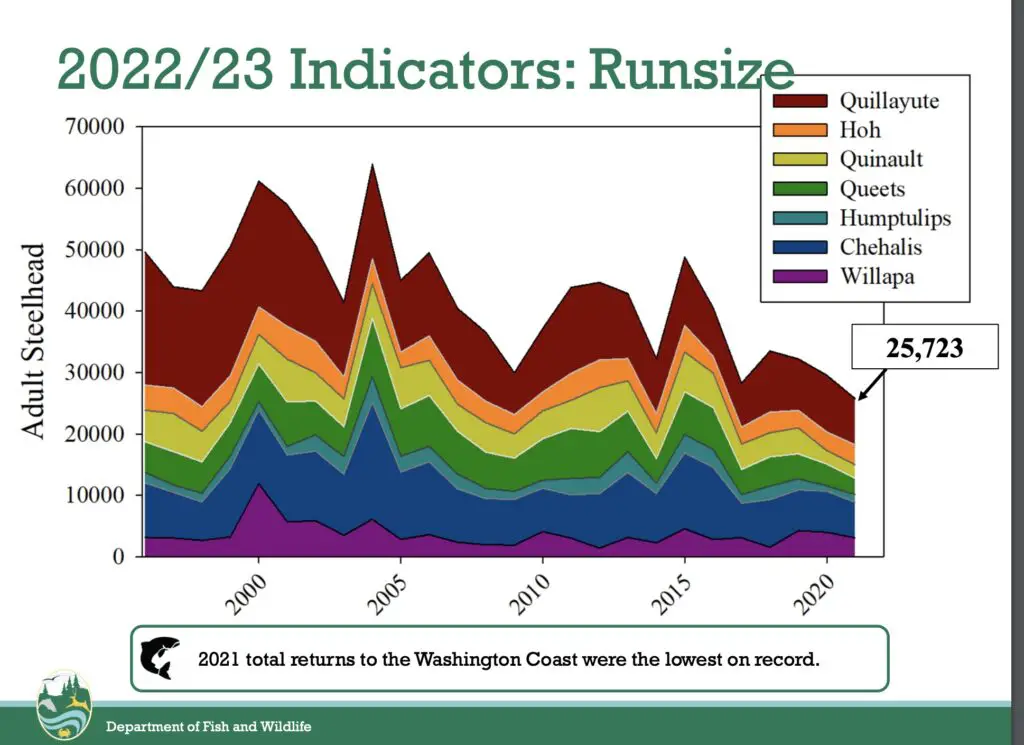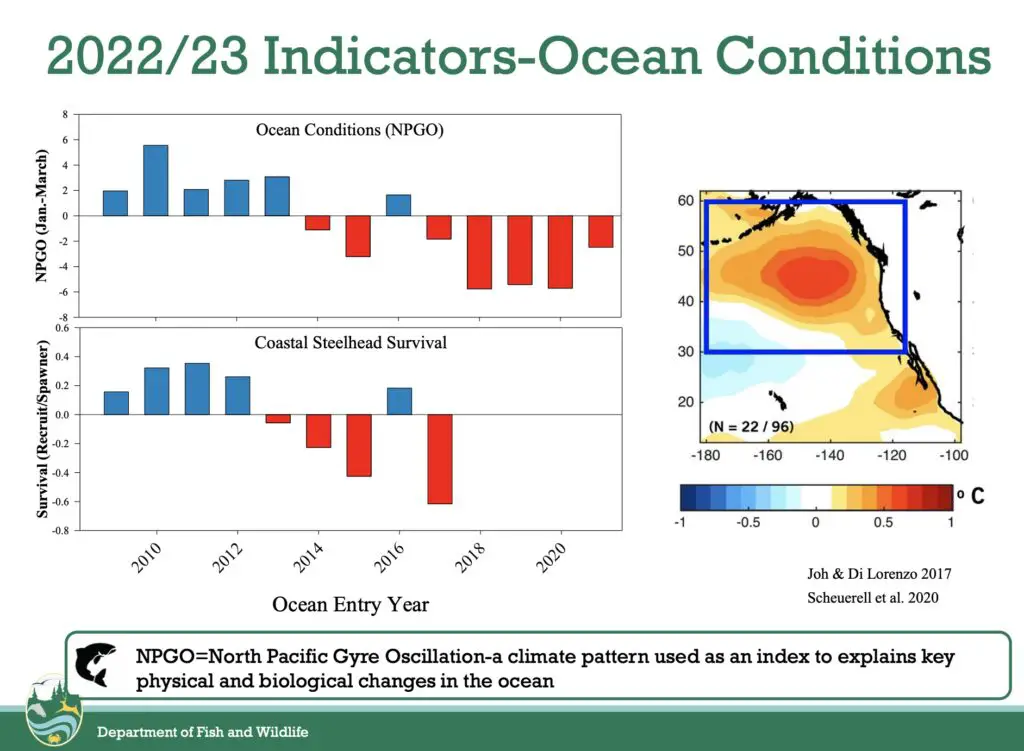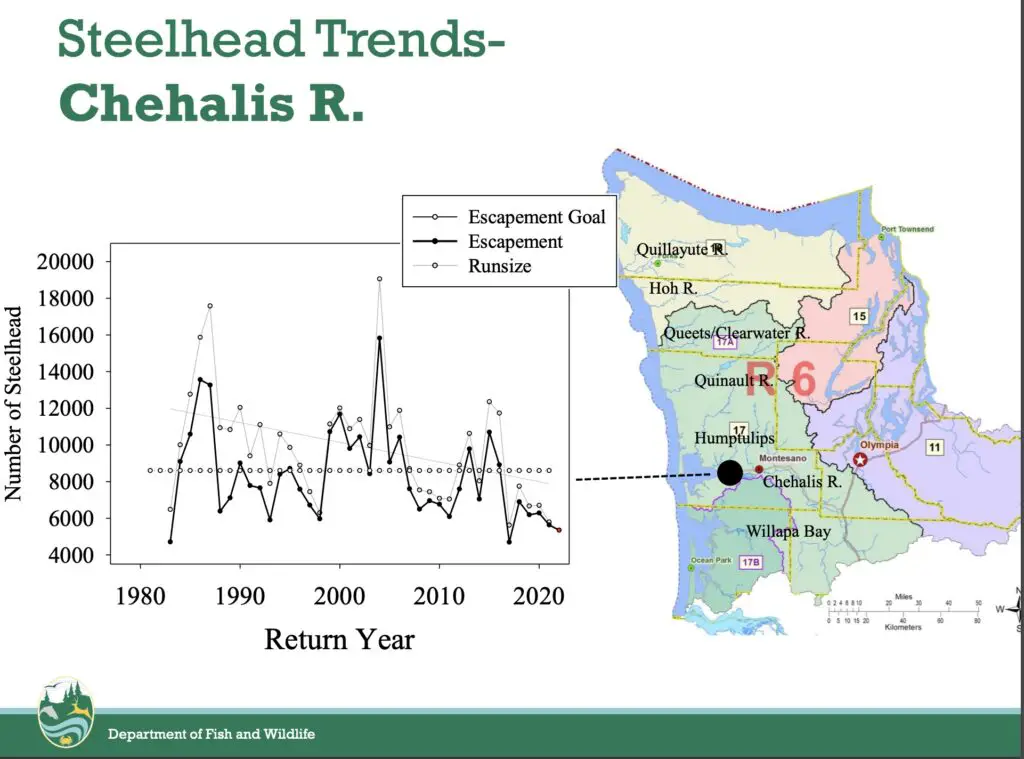
I hate to be the bearer of bad news, but things are not looking good for our Washington Coastal Steelhead season in 2022-2023, in fact, my “too early prediction” is that we won’t have seasons on *most* of our favorite coastal rivers this year.
Note: We’ve been provided clarity during the Nov 28th virtual town hall on the proposed regulations. You can read about those proposed (not yet final) regulations for the coastal steelhead season in 2023 here.
First of all, where this comes from is a meeting held in Sep, 2022 by the WDFW Commission, which included on the agenda an update on Washington coastal steelhead. You can track the WDFW timeline, meeting agenda, and resources, here.
I will share screenshots of several of the slides and then explain my prediction. Hopefully you have had, or are having a good salmon season, because this winter is shaping up to disappoint us with regards to recreational opportunity for steelhead.

The above slide shows the current status of the 6 river systems being monitored for coastal steelhead return health. As you can see, only the Hoh and Quillayute are above goals, and even then just barely.

The above slide paints a picture of the combined decline of coastal steelhead returns over several decades. “2021 total returns to the Washington Coast were the lowest on record,” to directly quote the slide.
Even though recreational opportunity was severely constrained in the 2021-2022 return year, we didn’t see a rebound in the returns.

This slide kind of highlights the doomer forecast…Coastal steelhead survival has followed the NPGO indicator, which has been negative for the last several years, forecasting more low returns for steelhead.

Lastly, we have to talk about the Chehalis River.
Why? This river system has the largest returns of hatchery steelhead and is the closest and most heavily fished. And especially the tributaries like the Wynoochee, Satsop, and Skookumchuck.
As much as we as steelhead anglers love the Olympic Peninsula rivers on the coast, we are most upset about lost opportunity on hatchery steelhead returning to the Chehalis.
Again, more bad news predictions for you…The entire Chehalis River will be closed to steelhead fishing in 2022-2023 even though thousands of hatchery steelhead will be returning.
Why? WDFW will publicly state that it’s due to the low returns of wild steelhead. And this is quite true. However, what’s not stated is a bit more challenging for anglers to accept because it puts an onus on the state and the tribes.
What follows will also not be highlighted or acknowledged at any point in the process of managing angler frustration.
Here’s the hard reality: If there’s not a healthy enough return of wild steelhead to take with gill nets, then recreational anglers are not allowed to have near zero impact on wild steelhead fishing below hatcheries for hatchery steelhead returns.
Some will read this and direct hate towards the tribe and co-managers, and that’s not my intent because I can see their side of things, and the law via the Boldt decision regarding 50/50 take is on their side here.
Before “we” showed up these runs were healthy enough for centuries to target via gill-netting. The decline is 100% caused by loss of habitat, pollution, over-harvest/predation in the ocean, and climate patterns that make the ocean less productive for steelhead.
And yes, gill-netting in the river harms runs that barely return with enough numbers to be viable. But they wouldn’t or shouldn’t without all the other factors.
This is where I believe the State should step in. There are alternative fishing methods to gillnets that allow sorting of hatchery and wild steelhead, but require an upfront investment and testing by tribes to implement and may not be as effective.
Shouldn’t the State purchase them though? What about studies on alternative gear effectiveness that other parts of the world have conducted in similar conservation efforts? When do we start those efforts given this is such an issue all over our region?
Would you be willing to pay for a steelhead stamp to fund alternative commercial gear that re-opens fisheries to angle for and harvest hatchery steelhead?
Do we really think the wild populations are going to thrive enough for gill net use in the near future in the current situation? We aren’t regaining all of the habitat that’s been destroyed. The ocean climate is not expected to get better, but worse as time goes on.
ESA listing and wild-only C&R fishing after decades of off-limits restriction is where we are headed. Is that what we really want as anglers?
Why not help the tribes selectively harvest hatchery fish and open fisheries in terminal areas for steelhead harvest by recreational anglers as well?
Why haven’t you heard anything about this side of the discussion?
Without some action, at some point, these steelhead hatcheries simply will be shut down as we’ve seen in Puget Sound rivers as managers and co-managers concede the wild steelhead will never support gill net harvest again…which means no more recreational angling. Period.
If I’m wrong on any of this, as I’m definitely using some “fill in the blank” logic here, feel free to reach out and help all of us understand the situation here.
Tell the whole story! Have the hard conversations while people still care enough about the issue.
Only “rich fly fisherman” support C&R? I think you are way off base….
Yeah, you’re right, that’s not a fair characterization of what’s going on and not a fair way to represent communities who’s livelihood depends on C&R fisheries. I have no problem with C&R or even that entire river systems would be C&R. I do think there is a segment of C&R folks that advocates for C&R to be everywhere, and actively seeks removal of opportunity to harvest salmon and steelhead in our rivers. I have a problem with that group. This website is all about harvest recreation and most of the anglers I know want to catch fish, but also bonk a few. If we remove the opportunity to harvest steelhead from our rivers we alienate several important angler groups who otherwise wouldn’t spend time on the water.
It is sad we couldn’t do something about this 30 years ago for the last 20 plus years we sport fishermen haven’t been able to keep a wild fish they get returned to the wild.When I catch a fish it doesn’t even hit the deck unless it is a hatchery fish. I think most of these wild fish are basically unharmed when returned this way. You just leave the net in the water and reverse it. I believe there is a better way to be selective we are . Fish traps or fish wheels set to work in the sides of the river. Gill netting should have been outlawed a long time ago it has damaged steelhead, salmon and sturgeon.